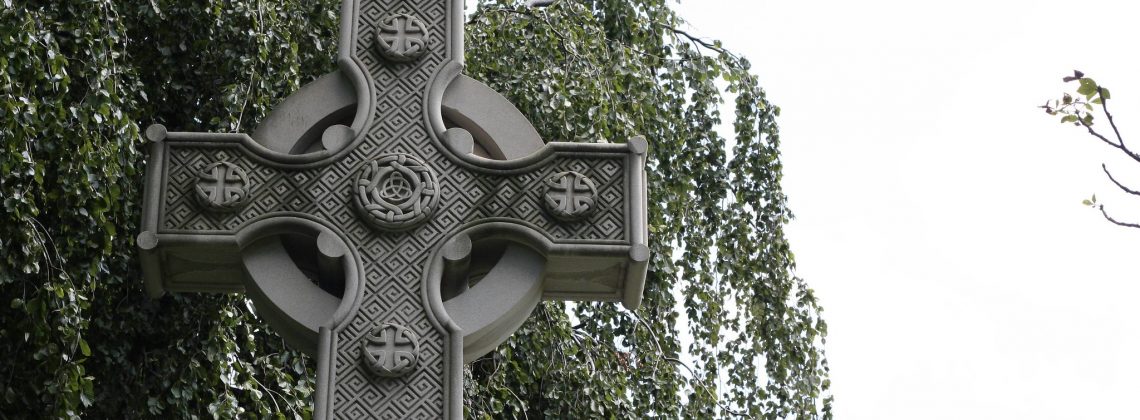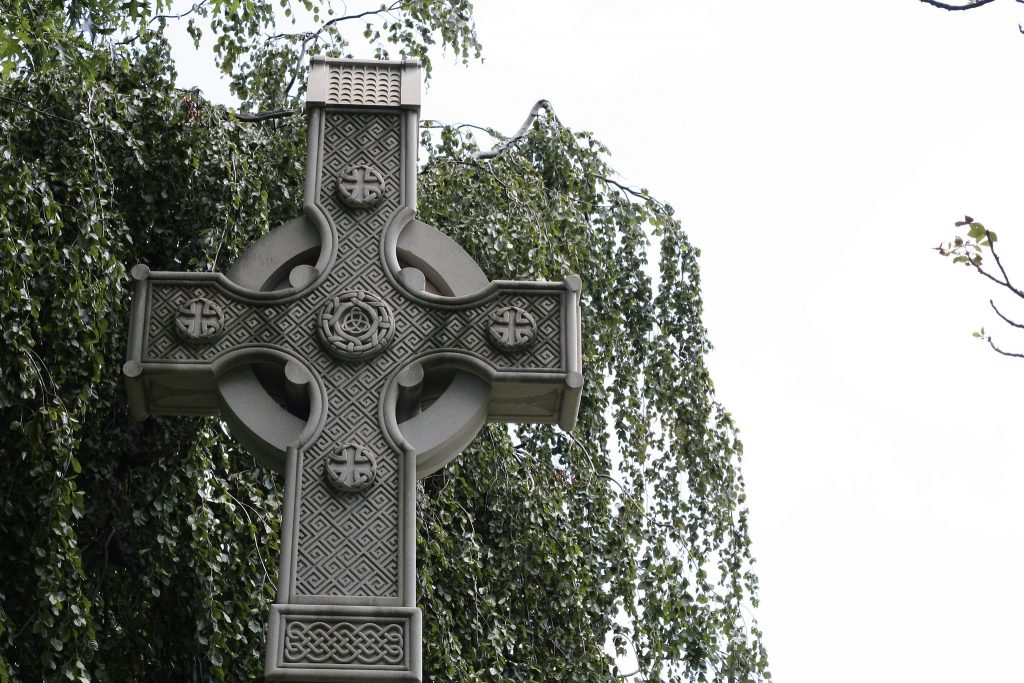

Early visions for Catholic Ireland provide a counterpoint to today’s rhetoric about “Christian America”
Last month, on the eve of the Triduum leading into Easter Sunday, I received an e-mail from a friend sharing a link to an article: “Why Good Friday is a Warning Against Far-Right Christian Nationalism.” True, the picture of a group of Christian ministers huddled in prayer around their golden . . . err, orange calf (i.e., a certain former libertine-in-chief) was unsettling, to say the least. Still, I have to admit that prior to receiving this article, written by an Episcopal priest, I had not been inclined to think of Good Friday as evidence that “2000 years after Jesus’s death, authoritarian politicians and corrupt religious leaders are still working together.” This sentiment recalled a sermon I heard decades ago at a Good Friday service at a leading Catholic university, in which the priest interpreted Jesus’s death as an indictment of the sin of capital punishment. American religious liberals share with their conservative counterparts a troubling tendency to misplace priorities when attempting to articulate their distinct public theologies.
Does politics inevitably corrupt religion? Is there such a thing as an authentically Christian nationalism in America?
These larger questions arose in part because I read this Good Friday article soon after returning from a trip to Ireland. The one Mass I was able to attend, a Palm Sunday vigil, was so sparsely attended that the priest had to assume all the speaking roles in his reading of the Passion. The waning of Catholic identity in contemporary Ireland is by now old news, but as readers of Current struggle to make sense of the rise of Christian nationalism in America the history of the Irish effort to forge a Catholic nationalism might offer some instruction, if only by contrast.
America was born in religious diversity, but modern Ireland was born in religious strife. A glaring exception to the confessional state model (“the religion of the prince is the religion of the people”) that emerged from the religious stalemate of the Reformation era, early modern Ireland featured Protestant sovereigns who ruled over a majority Catholic people. The Protestant elite belonged primarily to the Anglican Church of Ireland, who enticed Presbyterian dissenters from Scotland with land grants in exchange for doing the dirty work of keeping the Catholic majority in line.
Irish nationalism arose in the political ferment of the French Revolution. The mostly Protestant leaders of a movement called the United Irishmen realized that religious particularities stood in the way of the propagation of the universal Enlightenment ideals of the Revolution. To this end their leader Wolfe Tone sought “to abolish the memory of all past dissension and substitute the common name of Irishman in place of the denomination Protestant, Catholic and Dissenter.” Tone’s vision reflects both the Enlightenment ideal of tolerance and its insistence on the subordination of religion to politics. The rhetoric of erasure and substitution could reasonably lead a committed Protestant, Catholic, or Dissenter to wonder what place, if any, their faith would have in Tone’s Ireland.
The United Irish rebellion of 1798 failed to throw off English rule, as would subsequent rebellions over the course of the nineteenth century. The focus on achieving political freedom enabled nationalists from all three confessional traditions to evade the question of the role of religion in a future independent Ireland. Nationalism remained ecumenical, but over the course of the nineteenth century Protestants saw their leadership roles increasingly taken over by the growing Catholic middle-class. Protestant nationalists sought to neutralize Catholic influence by creating a new common Irish culture rooted in old Celtic myths that transcended denominational divisions. The poetry and drama of W.B. Yeats is perhaps the best-known example of this “invented tradition” of Celtic nationalism.
Catholic nationalists proved more than willing to incorporate pagan Celtic traditions into Irish nationalism—but as a complement to, rather than a substitute for, the Catholic faith that ordered the lives of the vast majority who would make up a future Irish nation. The romantic Catholic nationalist Padraic Pearse drew inspiration from the heroic feats of ancient Celtic warriors yet planned his great revolt against English rule to coincide with Easter: The sacrificial death and rebirth of Christ provided the symbolic model for the death and rebirth of the Irish people. The Easter Rising of 1916 was a triumph of symbolic politics. The absolute military failure of the rebellion led to the execution of Pearse and several other leaders, which in turn produced the martyrs necessary to inspire a larger scale rebellion that eventually achieved partial independence for Ireland.
But despite the nationalist leaders’ stated commitment to religious toleration, the Presbyterian minority, geographically concentrated in six northern counties within the province of Ulster, refused to join the new Irish Free State. The Presbyterians demanded and received their own state, Northern Ireland, which remains part of the United Kingdom to this day.
The fate of Church of Ireland Protestants in the new majority Catholic Irish Free State suggests that Ulster Presbyterians had little to fear in terms of persecution or revenge violence but much to fear in terms of cultural marginalization. Without the special privileges and protections granted the Protestant minority under English rule, Catholic Ireland was indeed an uncomfortable place for non-Catholics. More specifically, the new Irish state expected the general population to be on board with a specific ideal of rural, pre-industrial, Catholic Ireland. This ideal found its classic expression in a 1943 St. Patrick’s Day radio address delivered by then Taoiseach (Prime Minister) Éamon de Valera:
The ideal Ireland that we would have, the Ireland that we dreamed of, would be the home of a people who valued material wealth only as a basis for right living, of a people who, satisfied with frugal comfort, devoted their leisure to the things of the spirit—a land whose countryside would be bright with cosy homesteads, whose fields and villages would be joyous with the sounds of industry, with the romping of sturdy children, the contest of athletic youths and the laughter of happy maidens, whose firesides would be forums for the wisdom of serene old age. The home, in short, of a people living the life that God desires that men should live.
This pastoral vision owes something to the idealization of rural life found in British Romanticism. But it owes something as well to the Catholic vision of a properly ordered society articulated in the social encyclicals of the popes, from Leo XIII to Pius XI. No one living in de Valera’s Ireland would doubt that the Catholic Church was the arbiter of how God wished men to live.
My purpose here is less to explore the merits of this vision than to identify it as a vision in which a particular tradition of Christianity shaped the life of a nation, and to contrast this with the American versions of Christian nationalism in which Christianity always seems to serve some purpose other than—and perhaps one even more valued than—Christianity itself, be that purpose social justice or personal freedom. Perhaps American Christians should spend less time determining which cause Christianity should serve and focus more on the cause of Christianity itself.
Christopher Shannon is associate professor of history at Christendom College in Front Royal, Virginia. He is the author of several works on U.S. cultural history and American Catholic history, including the forthcoming American Pilgrimage: A Historical Journey Through Catholic Life in a New World, due this spring from Ignatius Press.